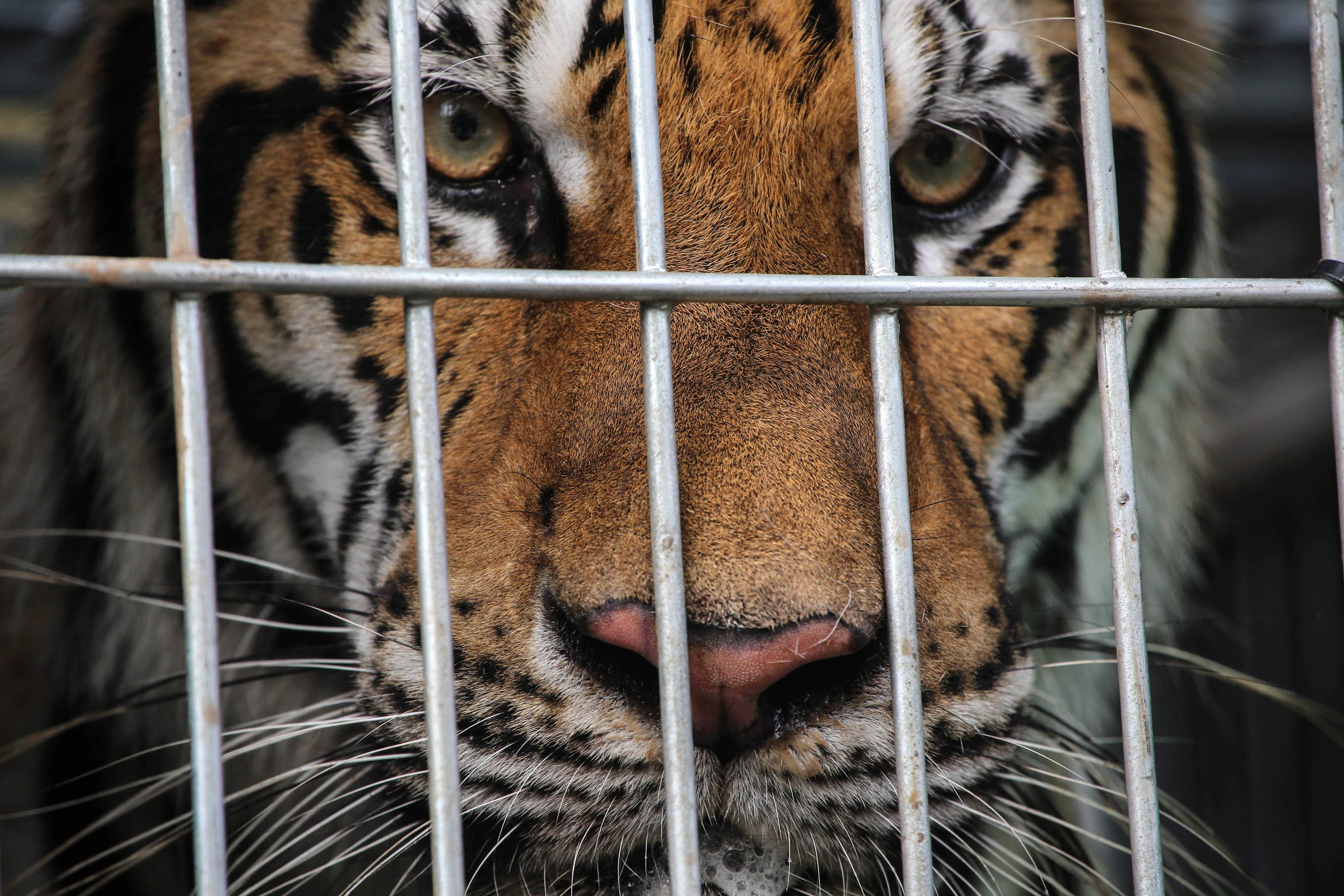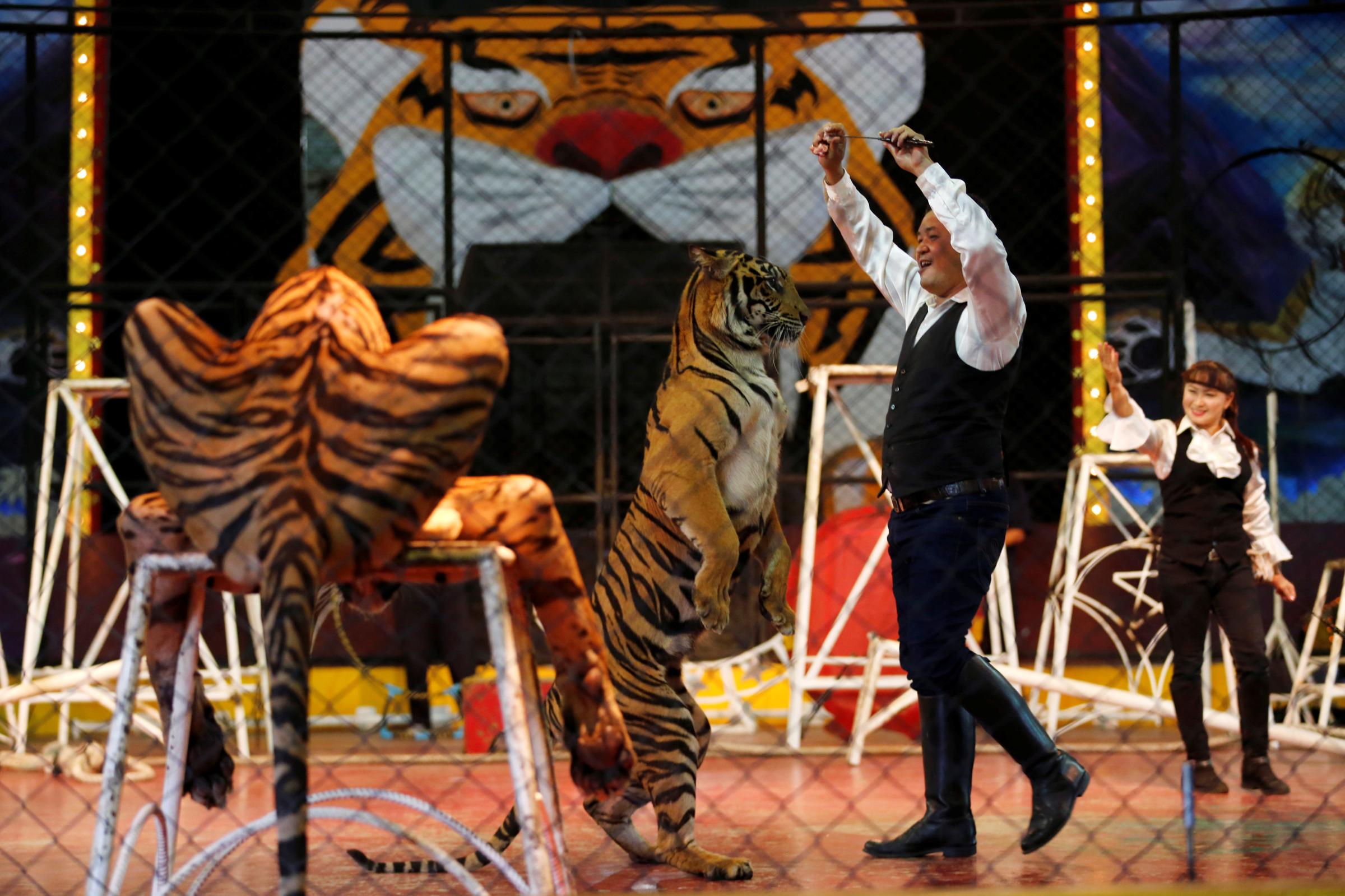
It was a special sort of gruesome. Forty dead tiger cubs that had been found in a freezer at one of the world’s most famous tiger reserves were laid out before the world’s press, flies swarming their now slowly decomposing frames.
More than 500 officers from Thailand’s Department of National Parks (DNP) swooped on the Tiger Temple, in the town of Kanchanaburi, a couple of hours’ drive west of Bangkok, on May 30, following years of allegations of illegal breeding and trafficking in the endangered cats.
The temple’s abbot has vigorously denied any impropriety. But a total of 147 live tigers were confiscated. Besides the thawed carcasses of the 40 dead cubs, there were 20 more found, kept in jars of formaldehyde. Two adult tiger pelts were also found, along with the body of a bear and around 1,500 tiger skin amulets, plus other trinkets apparently made of tiger teeth.
“They give these to people who donate money,” DNP deputy director Adisorn Noochdumrong tells TIME.
No longer. Shortly after the raid, the Tiger Temple was shut down.
It had always controversial. Founded in 1992, Wat Pha Luang Ta Bua Yanasampanno, as it was officially known, received its first cub in 1999. Buddhist temples have traditionally been places to take injured and abandoned animals. But Kanchanaburi became famous because it was the only place where visitors could see orange-robed monks and big cats living together in what appeared to be harmony.
Of course, the truth was rather more nuanced. The Tiger Temple was essentially a theme park, sprawling over 60 acres, with Tiger Island occupying 5 acres in the middle. Hundreds of deer, boar and cows roamed the outer scrub, along with gangs of civet cats, ponies and peafowl. The tigers were mostly confined to individual concrete cells, although they had the run of larger enclosures on a rotating basis. Every afternoon, a few were led on chain leashes to “the Canyon” — an artificial habitat complete with rocky cliff face and pond — for pictures with tourists.
“For us it was catch-22,” says Julianne Parker, an Australian who volunteered at the temple for seven years. “None of us liked running the Canyon, but at the same time we needed the tourists to earn money to do something better for the cats.”
In Thailand, all tigers technically belong to the government, but private owners are permitted to keep tigers, and breeding and using them for commercial purposes is legal with a zoo license. Last month, the World Animal Protection NGO reported that Thailand’s tiger-entertainment industry gained eight new venues over the past five years, with the number of captive tigers rising from 623 in 2010 to 830 today.

Tiger Temple had a zoo license — but it was only granted in April of this year, and to the dismay of critics. Some of the most vocal complaints come from former volunteers, who claimed that some cubs were illegally traded, with leaked documents from 2004 allegedly showing a deal between the temple and a facility in neighboring Laos.
Then, on Christmas Day in 2014, when all the foreign volunteers were off celebrating, three adult tigers were stolen from the temple grounds. The logistics of making off with three, full-grown tigers, from behind several layers of locked gates, mean an inside job was almost certain.
“O.K., awful things happened,” says Tanya Erzinclioglu, who volunteered at the park for six years, over coffee in Kanchanaburi. “But there was new management and everything seemed to be moving forward.”
Parker also says that, just before it was shut down, the Tiger Temple had started to change its stripes. Other than the three missing tigers, which they cannot explain, Parker and Erzinclioglu say that to their knowledge no cubs were traded during their respective seven- and six-year stints, and also deny accusations of that the animals were drugged to make them more complaint around tourists.
Erzinclioglu says she recognizes the two adult pelts seized as belonging to tigers that died naturally at the park. “Speed-breeding” practices had ended, she says, with no new cubs for over a year. The temple had even purchased adjacent land for a new sanctuary. “Each cat would have had 4 acres and no human contact,” says Parker, “but now that’s all been ripped away.”
The tiger cubs too were in the freezer for legitimate reasons, they say, as the temple’s former vet insisted that they keep deceased cubs — a litter’s natural mortality rate can push 40% — to prove they were not being trafficked. Moreover, Erzinclioglu points to a Tiger Temple Facebook post almost three months before the raid that explicitly stated there were dead cubs in the freezer and explaining why.
“The tiger cubs in the freezer was something the DNP knew about for years,” she says. Parker agrees: “It wasn’t an issue for me as I’d shown the DNP into the freezer lots of times — maybe twice a year.”
However, the DNP’s Adisorn insists otherwise. “I asked my staff and nobody knew that the temple kept the tiger cubs in the freezer,” he says. “And we never received any record of that.”
Whoever is right, there was something about the Tiger Temple that didn’t sit easily with Buddhism — not even Thailand’s brazenly commercial brand of it. It was hard to square the principle of ahimsa — “do no harm” — with the feeding $15,000 of farmed poultry to wild animals each week, not to mention coaxing the revenue from tourists. Each day, 200 to 300 people paid 600 baht ($20) to enter the park, plus an additional 1,000 baht ($35) to cuddle a tiger cub.
The business model was a mess. To pay for food and vet bills, and 90 full-time Thai staff, the temple needed tourists to part with cash in exchange for the chance of grabbing a selfie with a tiger. However, people only wanted to take photos with cute, tiny cubs. That meant breeding more of them, since cubs become unbridled adolescents when they reach the age of 6 months. From that age, impetuous and unaware of their own strength, they can be very dangerous.
During Parker’s time at Tiger Temple, the number of cats climbed from 40-odd to a peak of 147. “A lot of people did think that this was a huge moneymaking scheme,” she says, ”but a lot of the time we were just breaking even or sometimes in the red.”
Advocates of commercial tiger projects say they raise awareness of the plight of the endangered creatures, only 3,800 of which exist in the wild today. But the prevailing view is that they provide room for unscrupulous breeders to sell tiger products for supposed medical or decorative purposes, feeding an illicit business that ultimately leads to more wild tigers hunted.
“Tigers breed in captivity fairly easily,” says John Baker, managing director of San Francisco–based NGO WildAid, “so you really need to control the disposal of body parts so you’re not fueling this trade.”
The temple volunteers recognize this argument, but still say that the Tiger Temple was unfairly targeted, considering how other Thai operations treat their animals. At Sriracha Tiger Zoo near Pattaya, for example, the cats are made to jump through fiery hoops. (TIME did not receive a reply to repeated requests for comment from Sriracha Zoo.)

“There’s a lot I didn’t like about Tiger Temple, and a lot that I was trying to change, but it was definitely one of the better places for tigers in Thailand,” says Erzinclioglu.
What’s also clear is that, three months after the raid, the temple’s tigers are now in a worse state. Robbed of distractions, toys and space to prowl, several sport facial wounds from bashing their heads against the bars of their tiny government enclosures, where they spent 24 hours a day. One has already died.
“The government came and confiscated all the tigers, but they didn’t have anywhere better to put them,” says Baker. “They had to shut [the temple] down, as they broke the law, but it’s about how you do it so the interests of the tigers are cared for.”
The DNP says it tried to take away the tigers slowly, but after 10 were seized in the first month, the temple authorities refused to cooperate further, prompting the May 30 raid.
Adisorn also says the tigers “have enough room,” but Tiger Temple volunteers are demanding improvements, and have started a fundraising campaign to build larger enclosures at the DNP facilities. “I walk past the cages and go to call them still,” says Parker, eyes welling. “I just hope that something good comes of it all.”
Curiously, one large cat remains at the temple: a lion, called Petchy, who still roams his own leafy enclosure. The foliage so thick that the only clues to his continued existence are a ripped up toys left for him daily — and the occasional roar from deep in the undergrowth.
“We were told that he was rescued from a drug lord in Bangkok,” says Erzinclioglu. “But lions aren’t endangered creatures in Thailand, so nobody cares about him.”
More Must-Reads From TIME
- The 100 Most Influential People of 2024
- Coco Gauff Is Playing for Herself Now
- Scenes From Pro-Palestinian Encampments Across U.S. Universities
- 6 Compliments That Land Every Time
- If You're Dating Right Now , You're Brave: Column
- The AI That Could Heal a Divided Internet
- Fallout Is a Brilliant Model for the Future of Video Game Adaptations
- Want Weekly Recs on What to Watch, Read, and More? Sign Up for Worth Your Time
Write to Charlie Campbell / Kanchanaburi at charlie.campbell@time.com